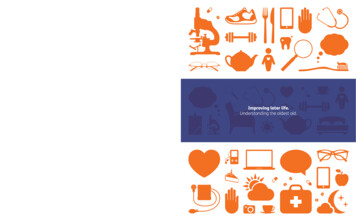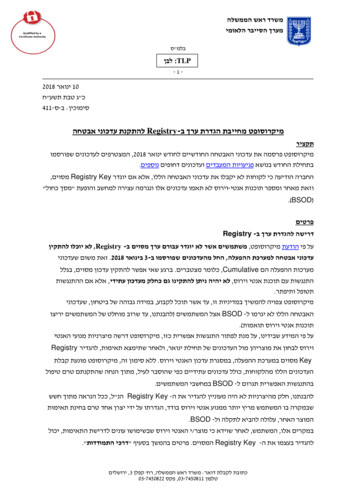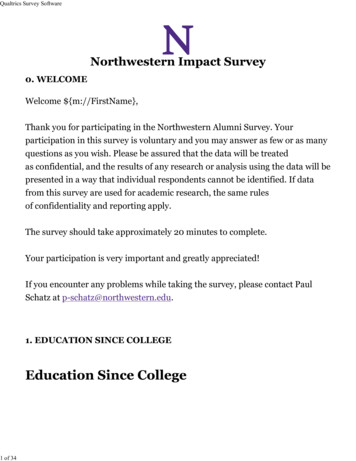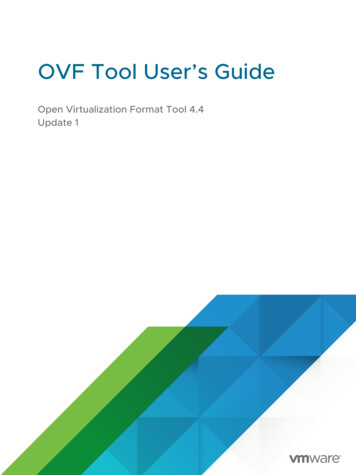
Transcription
Improving later life.Age UKTavis House1–6 Tavistock SquareLondon WC1H 9NA0800 169 80 80www.ageuk.org.ukImproving later life.Understanding the oldest old.
Age UK works to improve later life for the 14 million olderpeople in the UK. We do this by addressing health inequality,reducing loneliness and isolation, improving retirementincomes and tackling poverty and discrimination againstthose in later life in all its forms. We also speak for thelong-term interests of every one of us, so that experiencesof ageing grow better for each passing generation. Age UK 2013. ISBN 978-0-9568731-6-3Project editors:Dr Susan Davidson, Professor James Goodwin, and Phil RossallAge UK is a charitable company limited by guarantee and registered in England and Wales (registered charity number 1128267 and registered companynumber 6825798). The registered address is Tavis House, 1–6 Tavistock Square, London WC1H 9NA. Age UK and its subsidiary companies and charities formthe Age UK Group, dedicated to improving later life. ID200878 02/13
Improving later life.Understanding the oldest old.
Welcome.Welcome to Understanding the oldest old.In the course of our work with people in later life, we at Age UK havebecome increasingly aware of the importance of the group often calledthe ‘oldest old’, those in their mid-80s upwards. We have also foundthat not only is there a need for more research on this growing sectionof society, there is also a need for a clear summary of the evidence.What was formerly a small number of exceptional individuals israpidly becoming a whole new generation for families in this country,a ‘fourth generation’.Often people talk about the ‘older population’ (aged 65 and over) as ahomogeneous group. However, through our research, our contact withleading experts, and our engagement with older people, it has becomeapparent to Age UK that we all need to know more about people at theupper end, the ‘oldest old’.We are concerned that all of us who make decisions concerning thewelfare of this group need help to identify and understand the growingbody of evidence about them. The aim of this publication is to presentmessages about what we need to know and do, based on research, toprofessional audiences, such as civil servants, national and local politicians,doctors, nurses, carers and care workers, care home managers, charities the list could go on.In addition to this book, we have dedicated part of our website to thisissue, with in-depth materials, downloadable copies of this book andindividual chapters, diaries from people talking about what their livesare like at this age, and more. We trust that you find our presentationof the evidence useful.Michelle MitchellCharity Director General, Age UK4
Key messagesfrom the experts.Among the messages emerging from the researchconducted by the leading experts contributingto this book, several key points have emerged thatall professionals making decisions about the oldestold should know.OneSixLife is not over once you hit 85.In fact, most people over this ageare rather independent, feel thattheir health is good, enjoy a goodquality of life, and have more thana few years of life left.The social interaction needs we allhave continue to be as important,if not more so, when we get to bevery old.TwoAssumptions based on the youngerold can be totally inappropriate forthe oldest old.Loneliness and isolation tendsto increase the older we get,as we lose social networks,friends, and mobility. Even thosesurrounded by others, such asin a care home, can feel lonely;people may need to be supportedand encouraged to participateand engage.FourEightPeople get more diverse the olderthey get.ThreeSevenNo matter what chronological agea person is, it is still worth treatinghealth problems.People still want to be involvedin decisions about their lives,no matter how old they are.FiveNineEven the very old and frail needto get up and moving. There isnever an age where it’s best to sitand rest all the time!Not enough is known aboutpeople in the fourth generation.More research is needed.5
8ForewordJohn Beard28Use the six sensesMike Nolan9IntroductionTom Kirkwood32 isten to and careLabout the oldest oldLiz Lloyd10 bandon preconceptionsAabout the oldest oldAlan Walker34Know that lonelinessis not inevitableVanessa Burholt12I gnore age and look at the personFinbarr Martin3816Rethink old ageRudi Westendorp nderstand that we willUstill need care homesJulienne Meyer and Tom Owen40Maintain personhoodJulian Hughes1822266Learn from the oldest oldJohn Starr nderstand the importanceUof social relationshipsAnn BowlingFocus on outcomesin social careAnn Netten42 Prevent, identifyand treat depressionSusan Bedford46 llow for some hardAthinking at 85 and overIan J. Deary
50Help people live wellwith dementiaAlistair Burns7252 ealise that exercise isRstill key for the oldest oldRichard A. Ferguson74 Living long and ageing well:insights from nonagenariansMaeve Rea54Minimise sedentary behaviourDawn A. Skelton78 Know that incontinenceis not inevitableJames Malone-Lee56Maintain visionCatherine Dennison58Keep teeth and mouths healthyPaula Moynihan and Angus Walls62Support proper nutritionJohn Mathers64Manage sleepKevin Morgan68 Realise that multiplehealth issues are the normMarion McMurdo70Plan for better hospital careTeresa Dowsingand Simon Conroy80 Provide technology for allGail Mountain82 Design for the fourth ageJeremy Myerson84 ecognise and preventRelder abuseGloria M. Gutman86 See the need to know moreTom Kirkwood, Joanna Collertonand Carol Jagger nsure age is no barrierEto accessing health servicesIain Lang7
Foreword.5mpeople estimatedto be in the 85 age group by 2050ForewordToday, in many parts of the world, people can expect to live into their 80s.This is one of the great triumphs of the 20th century. It is also a greatadventure. For the first time in human history, it is becoming normal toexperience ‘old’ old age. We can sometimes forget how different this isfrom the past. Indeed, when today’s 85-year-olds were born, there werefewer than 10 million people living on the whole planet who had reacheda similar age. Yet by the middle of this century, there will be around 400million people over the age of 80 globally, the vast majority living in whatare today low- and middle-income countries. In the UK the numbers arejust as dramatic. Today, the Office for National Statistics estimates thatthere are nearly 1.5 million people aged 85 and over. By 2050, this will havegrown to 5 million.The world that today’s oldest old live in is a very different place from the worldthey were born in to. But how do they experience it? How should we addressthe challenges they confront? How do we provide the care they need, andhow do we break down the barriers that prevent their active participation insociety? The answers can be surprising. Indeed, we may need to shed someof the preconceptions we hold about this fourth age if we are to create thesort of world we would all want to live in as a 90-year-old.This book brings together a distinguished array of contributors to provide theirinsights on some of these questions. It is wonderful to read their stimulatingthoughts. They provide a vision of the world we might create, and the pathwe will have to follow to get there. I would like to congratulate them andAge UK for illuminating our way.John Beard MBBS, PhDDirector of the Departmentof Ageing and Life Course,World Health Organization (WHO).8
Introduction.IntroductionTom Kirkwood CBE, FMedSci, PhDDirector of Newcastle University’sInitiative on Changing Age.‘Today’s older people are the vanguard of an extraordinary revolutionin longevity that is radically changing the structure of society andaltering our perceptions of life and death.’ With these words I beganthe Preface to my book Time of Our Lives, published in the last yearof the last millennium – a book which I was audacious enough to hopemight even have messages for the politicians we elect to lead us intothe ‘uncharted territory of a greying world’.Who could have foreseen, in 1999, what the early years of the newmillennium would bring in terms of other upheavals – the terrorism of9/11 in 2001, the economic catastrophe of banking mayhem in 2008,and so much else? But the continuing dynamics of population ageingwere entirely predictable, and the world’s population has continuedto age as never before.It would be nice to think that our success in defeating premature,preventable deaths would be hailed for the triumph it truly is. It wouldbe cause for additional celebration if we had marshalled the sameingenuity that led to increasing lifespans towards making the mostof society’s greater expectation of life. It would even be good if we haddirected appropriate effort to understanding what life is actually likefor the vastly increased numbers of people living to age 85 and beyond.But we have done hardly any of the things necessary to prepare for therealities of population ageing, which is why this new book from Age UKis so timely and important.Great voids exist in our information about thelives of the oldest old in today’s world, and muchprejudice and misconception still obstructs thepath of identifying and instituting the necessarychanges. In this book are collected valuablepointers along the way of what needs to be donefrom experts who are still far too few in number.It is time to do more.9
Abandonpreconceptionsabout theoldest old.Key messagesAbandon the ‘deficit conceptionof ageing’ as a costly problem andthink in terms of how policy can helpto maintain and regain autonomyand independence, both physicallyand mentally.It is never too late: even in advancedold age it is possible to restore somelost physical and mental capacity.We need to overcomeageism and exclusion withregard to the oldest old.10Dignity and respect are critical: it is as easy forpractitioners to boost self-esteem as it is to undermineit. Too often, policy-makers and practitioners hold ageiststereotypes about the oldest old. At best these arepatronising and, at worst, they treat this group as beingeither a costly burden on the economy or just waitingfor death. Where they exist, these attitudes must beabandoned because they are discriminatory, damaging,wrong in factual terms and completely out of stepwith the changing face of later life. Those aged 85 andover are the most rapidly growing section of the UK’spopulation and policy-makers and practitioners needto adjust equally quickly to this new reality.There is now a huge body of evidence upon whichto base a new approach, including the Growing OlderProgramme (www.growingolder.group.shef.ac.uk),the New Dynamics of Ageing (www.newdynamics.group.shef.ac.uk) and the English Longitudinal Studyof Ageing (www.ifs.org.uk/ELSA).This research evidence emphasises why we needto overcome ageism and exclusion with regardto the oldest old.
Alan Walker FBA, FRSA, AcSSProfessor of Social Policy and SocialGerontology and Director of theNew Dynamics of Ageing Programme.HeterogeneityDignity is crucialJust like every other section of thepopulation, those over 85 varywidely in terms of demography,social and health characteristics.Ageing is unequal: more than threein four women aged 85 and overlive alone, compared to two in fivemen. The oldest women are morelikely than their male counterpartsto rent accommodation (one-thirdvs one-fifth). Poverty is highestamong very old women.An older person’s identity isthreatened when their autonomyis restricted; for example, followingsevere illness or a fall. Thisundermines confidence and selfesteem and this is especially thecase when personal care is required.In this situation, practitioners canwork wonders by supporting peopleto regain some of their reducedcapacities and by closely observingthe Dignity Code gnity-Code.doc).Variationsin capacityThere is no clear evidence of asudden decline in health at 85and self-rated health is no differentbetween those aged 80–84 andthose 85 . Significant proportionsof the oldest old are not severelydisabled and can look afterthemselves. Even among thosesuffering severe activity limitations,self-care is the most commonform of support.The rapid transformation of later lifeand the growing importance of theoldest old demand that we abandonthe ageism that stultifies policy inthis field. Instead, this group needsto be fully integrated into an activeageing strategy that includes bothprevention (at earlier stages of thelife-course as well as into late oldage) and fast remedial action whenautonomy is threatened.Functionnot ageAgeing is not a matter ofchronology but restricted activity.Most people begin to feel ‘old’as a result of illness or disability.Rather than assuming that this isinevitable, because people are old,or permanent, actions are neededfast to restore function (physicaland mental) or to re-skill by findingnew ways to do things, such asopening jars. The evidence is clear,even among frail older people intheir 90s, mild exercise can havebeneficial effects both physicallyand mentally.11
Ignore ageand lookat the person.Key messagesThe oldest old are more diverse in healththan the younger old; they cannot all betreated the same.Finbarr Martin MD, MSc, FRCPConsultant physician at Guy’s andSt Thomas’ NHS Foundation Trustin London and Honorary Professorof Medical Gerontology at King’sCollege London. He was the electedPresident of the British GeriatricsSociety from 2010 to 2012.Chronological age is a weak predictor of lifeexpectancy and response to treatments.Many illnesses associated with age can betreated or avoided, especially if the oldest oldreceive good co-ordination across servicesand specialities to offer the best treatment.The oldest old have lived long enough to have acquired, on average,several specific conditions (e.g. diabetes, osteoarthritis and heartdisease), a range of age-associated impairments of bodily andmental functions (like strength, balance and factual memory)and the trials and satisfactions of life events. But diversity growsrather than diminishes. Generally, the health and healthcare needsof older populations is related to proximity to death, rather thanchronological age. Since there is wide variation of health and lifeexpectancy, chronological age becomes a weaker predictor of need.12
Ignore ageand lookat the person.Intriguingly, while women are on average morefrail than men of similar age, they survive longer,for reasons not yet understood. Social participation,with responsibilities as well as support, seemsimportant in preserving resilience as well as wellbeing.Society, neighbourhoods and practical issues likephysical access are therefore influential in enablinga healthier old age.Age-attuning healthcare is a significant challengeto all health services. The approaches developed andproven of value to middle-aged people are inadequate.A multidisciplinary approach is needed, which crossestraditional service boundaries. For example, mostoperations are now performed on older people.The oldest old can certainly benefit. But the greaterrisks they face can be anticipated and amelioratedby joint working between surgeons, anaesthetistsand geriatricians, so that chronological age itself neednever be sufficient reason to deny possible benefit.Individual differences have accumulated overthe life-course, and socio-economic factorshave a predominant influence. The sum totalof problems or impairments means that individualsalso differ in their ability to weather the nextsetback, illness or injury. Loss of reserve or resilienceis called frailty, and this can be measured througha comprehensive assessment, which is moreholistic than a list of diseases.14Difficulties in managing day-to-day tasks merits amedical assessment as well as a social care response.A proactive approach is needed, particularly for thosewith disability. This includes care home residents whoseneeds may change and frequently require specialistinput as well.Evidence is building about general measures to delayor reduce frailty. Regular physical activity is key, althoughmany will be limited in the scope or intensity of what’spossible. Challenging balance and co-ordination, withinsafe limits, preserves functional mobility and reducesfalls. For frailer individuals, this needs tailoring by healthprofessionals.
Ignore ageand lookat the person.Generally, the health and healthcare needs ofolder populations is related to proximity to death,rather than chronological age.Appetite and weight may fall in late life but protein needsremain high and advice on adjusting the balance of foodsmay be needed. There are no anti-ageing wonder vitamins,but many people who lose weight or eat too little will simplybecome deficient in some standard requirements, such asfolic acid; and most housebound older people are short ofvitamin D. This justifies routine supplementation or at leastmeasurement to check whether it is needed,before it causesproblems. Ongoing research is likely to identify additionaltreatments to address the problem of sarcopenia (smallerand less effective muscles).Treatment for common conditions such as hypertensionshould be tailored for the individual. Evidence obtained fromresearch using younger, fitter subjects needs to be factoredwith a mind to the older patient’s short- and long-termhealthcare objectives. These are likely to change towardsthe end of life. The benefits of some treatments decline,but for others the absolute benefit may be greater for olderpeople because of the greater underlying risk. However,the risks of adverse effects and burdens may increase inthe presence of multiple illnesses or frailty. Polypharmacy(taking multiple medicines) itself increases the risk of adverseeffects, so six-monthly reviews of indications and side effectsare justified. Completing the circle, frailty increases the risksof polypharmacy.Thinking about individual objectives and priorities naturallyincludes considering events towards the end of life. Thisproactive approach gives both doctor and patient a chanceto plan for dignity and wellbeing, avoiding unnecessarytreatments and the muddle that can otherwise arise in a crisis.15
Rethinkold age.Key messagesThose of us who reach 85 have, on average,at least five years more to live; it is worth payingattention to their health, needs and desires.Rudi Westendorp MD, PhDProfessor of Medicine at LeidenUniversity, the Netherlands.Director of the Leyden Academyon Vitality and Ageing. He isco-investigator of variousobservational and experimentalstudies into the determinantsof health and disease in old age,including the Leiden 85-plusstudy, the PROSPER trial and theTRUST consortium.In this fourth age of life, risk factors of diseaseand markers of health are markedly differentwhen compared to those at younger age, so wecan no longer take accepted predictors of illhealth as accurate in relation to the oldest old.What we now need is a paradigm shift in ourthinking: solutions that fit the younger old maynot be appropriate for the oldest old.The oldest old are rapidly increasing in numbers, a shining symbol ofthe sociomedical improvement of our societies. Life expectancy of menaged 85 is now about five years, long enough to envisage a personalmaster plan. Women already have a couple of years longer.Insights from current biological and medical research reveal that thisnew dawn of our lifespan is far more plastic than we have yet appreciated.Therefore it shouldn’t come as a surprise that life expectancy increasesby an extra one or two years per decade. Fortunately, self-rated lifesatisfaction beyond age 85 is at least as high as during our ‘middle’ and‘third’ age, despite deficits in physical and mental functioning. Nevertheless,we need to address the versatile goals and ambitions as perceived by theoldest old themselves.16
The leap forwards in preventing and treating diseasethroughout our prime years has contributed enormouslyto the length and quality of life that we now enjoy. Whilethis was happening, however, we were not investing in ourunderstanding of the consequence of this, e.g. in just a fewgenerations, the age at which 10 per cent of the populationis still alive increased from 70 to 80 years of age. Disease,morbidity and death in very old age actually occur in a‘knowledge shadow’, as we have almost systematicallyexcluded the very old from our research and have thereforetoo little data to fully exploit the potential of our presentand future longevity.In the Leiden 85-plus study we – and other investigators whohave included very old people in similar observational studies –have shown that, among others, high cholesterol, hypertension(high blood pressure) and low thyroid hormone have lost theirvalue for the over-85s to predict disease and disability, and haveinstead become markers of health!Some argue that these very old are a rather selective pickof survivors who appear resistant against high cholesterol,hypertension and low thyroid hormone. This reasoning maybe not false, but it does not explain the paradoxical findingof these biomarkers to predict longevity in the fourth age.The oldest old are rapidlyincreasing in numbers,a shining symbol of thesociomedical improvementof our societies.Use of biomarkers and associatedinterventions that may have to bereconsidered is as follows. The PROSPER study, a randomisedcontrolled trial of cholesterollowering in (very) old peopleshowed cardiac benefit but nosurvival advantage, a findingthat is not at odds with theexperimental data at middle age. It is as yet far from clear whetherdecreasing blood pressure in frailolder people provides benefitand recent data suggest that itmay well be worthwhile to studywithdrawal of anti-hypertensivemedication to protect the brainand cognitive function. Within the TRUST consortium,randomised experiments areongoing to provide an answeron whether to treat or not totreat the (very) old with thyroidhormone, whereas we would nothesitate if they were younger.To be able to enhance self-ratedlife satisfaction of the oldestold, we urgently need innovativestrategies that appropriatelyaddress their needs and desires.These necessitate a paradigmshift in our thinking as diagnosesand solutions that fit the youngerold may not be appropriate for theoldest old. When not addressedproperly, life satisfaction and thelength of life may even diminish.The Leiden 85-plus 0600473042017
Learn fromthe oldest old.Key messagesHealth and social care professionals, along withpolicy-makers, should listen to the story of thelives of people aged 85 years or more. They havemuch to learn from the stories of those whoselives have gone well enough to have survivedso long.Even the very old generally rate their qualityof life as good or very good.Having a good late life depends a lot on eventsand actions in younger life, so healthy behavioursneed to be encouraged in people at every ageto optimise everyone’s chances of ‘good’ ageing.18John Starr FRCPEdProfessor of Health & Ageing at theUniversity of Edinburgh and Directorof the Alzheimer Scotland DementiaResearch Centre.
Learn fromthe oldest old.For centuries our view of old age has been dominated byWilliam Shakespeare’s dismal description of it in As You Like It:Last scene of all,That ends this strangeeventful history,Is second childishnessand mere oblivion,Sans teeth, sans eyes,sans taste, sans everything.But over the last 50 years or so this picture has been transformedby mass population ageing. With so many more people survivingto old age, research on larger samples of older populations hasbecome feasible and this research reveals that this period of one’slife is typified as much by continuity as it is by loss.If we want to have a good oldage, we have to start young;that is, what is technically termeda life-course approach to ageingis required.20
Learn fromthe oldest old.For example, in our studies of people born in 1921 inScotland, we found that even approaching the age of90, over a quarter of a person’s mental abilities can beexplained by her ability when she was 11 years old; thatis at least a quarter of how a person performs on testsof mental ability is fixed across eight decades of life(there is more on this in Professor Ian Deary’s article –see page 46). Similarly, more than half of the people wesurveyed had their own teeth. We also measured theirvisual acuity, wearing glasses if necessary, and foundthis on average to be 6/9, which is the sixth line down onthe standard Snellen chart of letters used by opticians.We did not measure sense of taste.Given this picture of relative preservation of youthfulattributes into old age, it is unsurprising that peopleaged 85 and over generally rate their quality of lifeas good to very good. In fact, physical limitations andlosses are not particularly strong predictors of howsomeone will rate their quality of life at this age.Instead, aspects of mental wellbeing such as mood,personality and lifelong intellectual ability are themost important factors. And here is a crucial point:although mood may vary over fairly short periods,other aspects of our psychological being, such as ourpersonality or mental abilities, are things that remainrelatively fixed throughout our lives. Hence, if we wantto have a good old age, we have to start young; thatis, what is technically termed a life-course approachto ageing is required.What is striking about Shakespeare’s ‘Seven Agesof Man’ is the discontinuity of each age, representedas separate acts of a play, as if one person exitsfor another to enter. But life-course studies, whichnow extend into advanced old age, show this to befundamentally wrong: there are no discontinuities,it is the same ‘us’ in many ways at age 90 as at nineyears old. As the physical health of younger membersof the population improves, we can expect this tolead to physically healthier older members in duecourse. What is needed is attention to mental health:for example, we know that even mild levels of stressincrease the risk of both dying early and dementia.So Shakespeare got it wrong for the 21st century –no longer can old age be said to be a time ofdevastating loss, nor can we reckon our lives to bemade up of separate selves, the infant, the schoolboy,the lover, etc. But maybe the play’s title still holdssome truth for us: it is more how we consider thestory of ourselves that determines our quality of lifeat 85 years and beyond – in Shakespeare’s words,it remains a matter of ‘As You Like It’.To find out more about the research behindthis article, go to www.ccace.ed.ac.uk21
Understand theimportance ofsocial relationships.Key messagesBe aware that social relationships are very important and should not betaken for granted. We all need to build and nurture our social relationshipsthroughout life, so that we enter very old age with enough reserves of theseto compensate for relationship loss due to deaths, frailty, or moving home.Provide information about how older people can maintain feelings of beingin control over their lives as they become frailer. This includes examplesof how to cope or compensate for activities as these become more difficultto carry out.Enhancing quality of life in old age is attracting increasingpolicy interest. Quality of life is an accepted measure of outcomesof government policies, including health and social care.Our research on quality of life was unique in asking olderpeople themselves, including very old and frail people, abouttheir quality of life, rather than relying on ‘expert’ views.22
We used the results to develop a questionnaire aboutquality of life, relevant to older people that can be usedto measure effects of public policy. We found that the most important influences onwhether we experience a good, rather than bad,quality of life in older age are one’s social relationships,and having social roles and activities.Many very old, frail, people mentioned the importanceof having someone for ‘companionship’, ‘to take me out’,‘to make life bearable’; and of having social or voluntaryactivities, not just for their self-esteem, but to help them‘keep busy’, in order to stop them worrying, feelinglonely, or dwelling on the past.Ann Bowling BSc, MSc, PhDProfessor of Health Sciences,University of Southampton. The next most important influence on qualityof life mentioned was having good health andphysical mobility.Other important influences included: enjoyment of one’s home, good community facilities,and feeling safe a feeling of wellbeing and contentment, feeling incontrol of life, as well as having an optimistic outlook(‘looking on the bright side of life’) having independence and control over their daily lives(to be able to continue to live independently in theirown home, rather than residential care, was importantto people) feeling they had enough money to pay one’s billsor to enjoy oneself (e.g. to be able to have day tripsor holidays).These were also the most important influences on theirratings of their own quality of life, on a scale rangingfrom ‘So good, could not be better’ to ‘So bad, could notbe worse’.23
Understand theimportance ofsocial relationships.In each of our studies, feelings oflittle or no control over their lives alsostatistically increased people’s risk –by over three times – of rating theirquality of life as bad rather than good,compared with those who felt theyhad a lot to some control.Having difficulty walking was also arisk factor for poor quality of life, butit was not as influential statisticallyas social support and feeling in control.The risk factors for poorer socialsupport included being in the oldestold-age groups, and being a memberof an ethnic minority group.Our results are consistent withan analysis of all published studiescombined, showing that socialrelationships are as important asnot smoking, having a healthy dietand exercising for mental and
Welcome to Understanding the oldest old. In the course of our work with people in later life, we at Age UK have . In addition to this book, we have dedicated part of our website to this issue, with in-depth materials, downloadable copies of this book and . men. The oldest women are more : '.: . 1 3. Age UK London WC1H 9NA 0800 169 80 80










